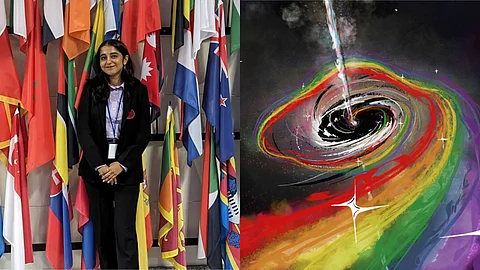
- HOMEGROWN WORLD
- #HGCREATORS
- #HGEXPLORE
- #HGVOICES
- #HGSHOP
- CAREERS
- ABOUT US
- CONTACT US

Among the 330 Americans who had been to space as of 2015, only one, Astronaut Sally Ride, identified as queer — a fact that wasn't publicly revealed until after her death. A part of this has to do with the rigid heteronormative standards of the US Army since most astronauts come to NASA's space program through the military. Other countries don't fare much better either. While queer scientists and engineers flourish in the aerospace industry on earth, when it comes to spacefaring, the vast expanse of space remains out of reach for the LGBTQIA+ community. Such systemic exclusion of queer individuals from space exploration begs further and obvious questions about what kind of culture we are taking to space? What ideas, traditions, beliefs, and practices? And what does that mean for the future of spacefaring?
Space Pride, an international non-profit advocating for LGBTQIA+ inclusion in the space sector, is slowly changing that. Earlier this year, Space Pride sent 'Humanity’s Journey into the Galaxy: We Are All Made of Stardust', a digital artwork created by Rania Djojosugito and Khushi Shah, to the moon in a giant leap for queer representation in space. The piece is part of the ASPIRE One Record, a project by the Interstellar Foundation, and was delivered on Firefly Aerospace’s Blue Ghost Mission 1 and Intuitive Machines’ IM-2 mission, backed by NASA.
Firefly Aerospace’s Blue Ghost Mission 1 delivered the artwork both in digital form on a Lifeship Pyramid and etched physically on a NanoFiche disk on the Blue Ghost Lander to the Mare Crisium on January 1, 2025; and Intuitive Machines’ IM-2 mission carried the piece aboard the Lonestar Freedom Payload on the Athena Lander to the Mons Mouton region near the south side of the Moon on February 26, 2025. These missions were among the first to carry LGBTQIA+ representation to the Moon, marking a pivotal moment for queer representation in space exploration.
Recognising the underrepresentation of queer minorities in the space sector, the idea to include the LGBTQIA+ artwork in space was born from a conversation between Protea Vale and Nick Searra — the founding members of Space Pride and Interstellar Foundation respectively. In 2023, Space Pride was invited to submit art to the ASPIRE One Record — a time capsule of human creativity, memory, and identity. The piece, co-created by Rania Djojosugito and Khushi Shah, was designed with input from the Space Pride community to represent diversity, equality, and inclusivity in space. The artwork symbolises the infinite potential of space, paired with the singularity of a black hole — a metaphor for the unity and boundless opportunities of the LGBTQIA+ community.
The artwork is now a permanent part of lunar history, and represents the intersectional, queer, diasporic communities' claim on not just space, but humanity's collective future.
About The Artist
Khushi Shah is an engineer, designer, and artist with experiences spanning field engineering in India, communication design across the Asia Pacific region, founding non-profits in the EU, and creative directing in the UK. She is currently studying Strategic Design at Parsons School of Design in New York City.
If you enjoyed reading this, here's more from Homegrown:
Melodies Across The Cosmos: How A Classical Indian Track Made It To Outer Space
Kazoo Is The First Feminist Magazine For Little Girls Who Love Outer Space & Climbing Trees
Indian Short Film 'The Astronaut And His Parrot' Makes Sci-Fi Seem Like Child's Play
